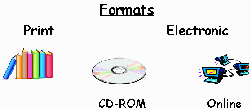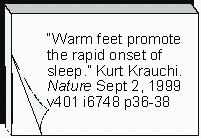| |
How to Find Articles
Contents
The Process | What You'll Find
Choosing a Journal Index |
What a Journal Index Tells You
Searching Tips
- Looking for journal articles is often a two step process!
- Search
in a journal index to identify articles.
- A journal index is a very helpful tool for finding published articles on your subject of interest. It tells you in which journal and in which issue an article appears.
- Since no one has the time to look at and sort through all the thousands of articles that are published in magazines, academic journals and newspapers, indexes are very useful. Journal indexes (or databases if they’re electronic) are commercially produced so they cover journals that the library may not own.
- Check
in the library catalog to see if the library owns the journal. Some electronic journal databases provide the full text of some or all articles. In that case, you can download, print or email the article right then and there! See Quick Tips for CUNY+ for information about searching the library's catalog.
|
About Journal Indexes
Types
- General
- Infotrac, Lexis-Nexis
- The New York Times Index
- Subject Specific
- PsycINFO
- Modern Language Association

|
What You’ll Find
- Scholarly Resources:
- Books, journal articles and other publications created by scholars and experts in their fields. Generally based on research. Most importantly: scholarly publishing has gone through the peer review process, described below (Ex: Modern Drama).
- Popular Resources:
- Books, magazine and newspaper articles, and other publications that report facts or opinions. Popular resources have not gone through the peer review process (Ex: Newsweek or New York Times).
- Peer Review:
- The process by which a piece of scholarship is evaluated and judged for quality and accuracy by other scholars and experts, before it is published.
Choosing a Journal Index
- Many Journal indexes are only available in print, so be sure to ask a reference librarian for help.
- Link to an alphabetical list of electronic journal indexes
- Link to a list of electronic resources by subject
What a Journal Index Tells You
- Citations:
- Most journal indexes give you a citation to an article. The citation is the article title and author, the journal title, and the volume, issue number, pages and date. See the typical citation for an article at right.
- Abstract:
- Sometimes article citations are accompanied by an abstract or summary.
- Subjects & Descriptors:
- Article citations are often accompanied by subject headings (or descriptors). Descriptors provide good terms for continued searching, as well as showing what the article is about.
|

Article Citation
|
Searching Tips
- Print:
- When searching a print index, check the index under your primary subject, and then look for subdivisions. For example:

- Electronic:
-
| One of the great things about electronic searching, is KEYWORD searching. |
| This means you combine terms you would like to find together in a single document. For example:
|
 |
- Boolean Logic:
- Boolean Logic, named after George Boole, a 19th century mathematician and logician, allows you to combine keywords in complex ways.
 |
- AND:
- Narrows your search. Using AND means that all the terms you use will appear together. JAVA AND SOFTWARE will return results about Java software, not Indonesia or coffee
- OR:
- Broadens your search. Using OR means one or the other term must appear, but not necessarily both. CAGES OR ENCLOSURES will return results with either term, or both
- NOT:
- Narrows your search. Using NOT excludes terms from your search. APPLE NOT COMPUTERS will return results about apples but not Apple computers
- ( ) :
- Parentheses allow you to create complex searches
- Ex: JAVA NOT (COFFEE OR SOFTWARE) will return results about Indonesia
- (CHILDREN OR KIDS) AND (WOODWORKING OR CARPENTRY)
- (PETS NOT BIRDS) AND (CAGES OR ENCLOSURES)
|
|





